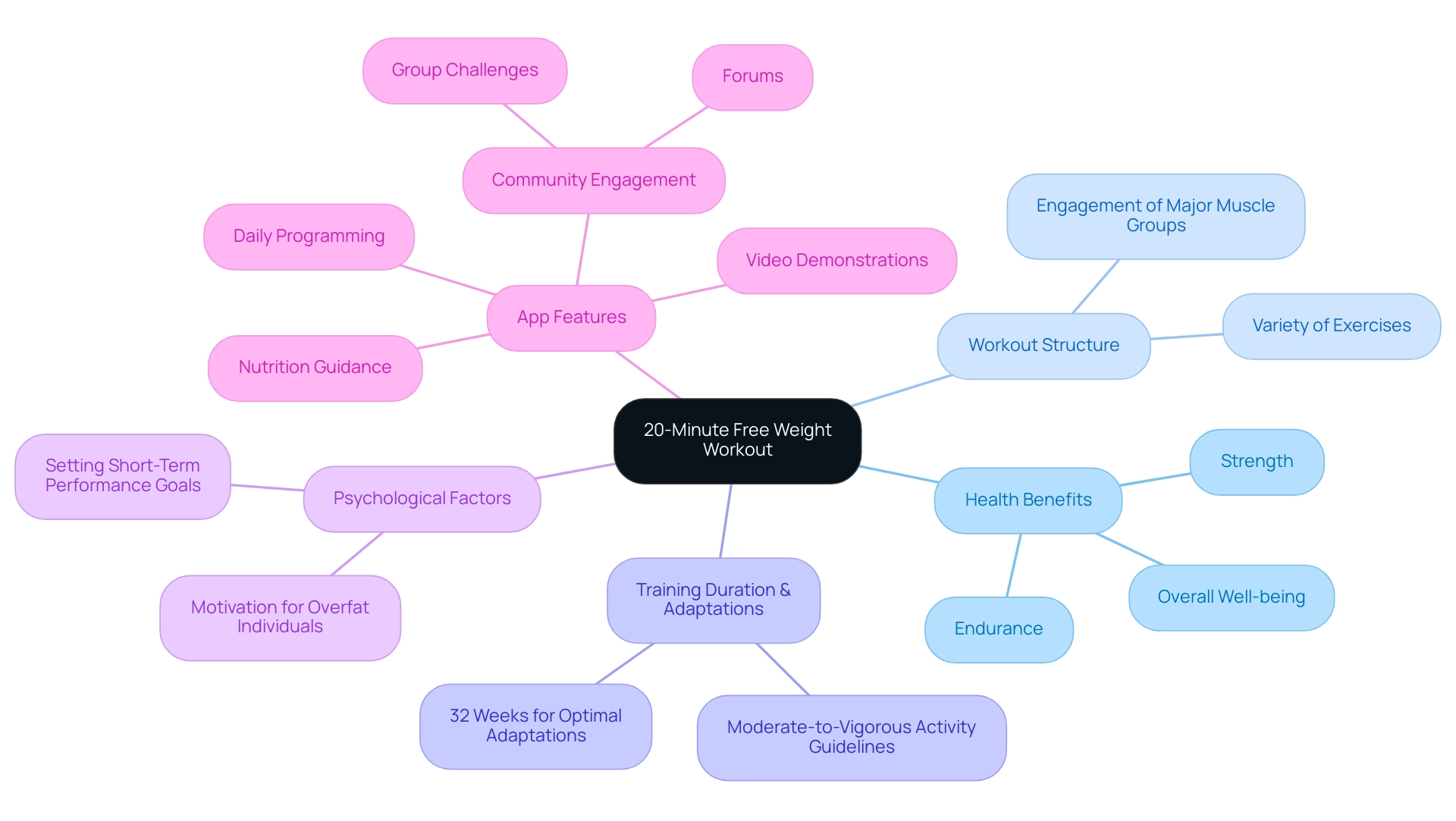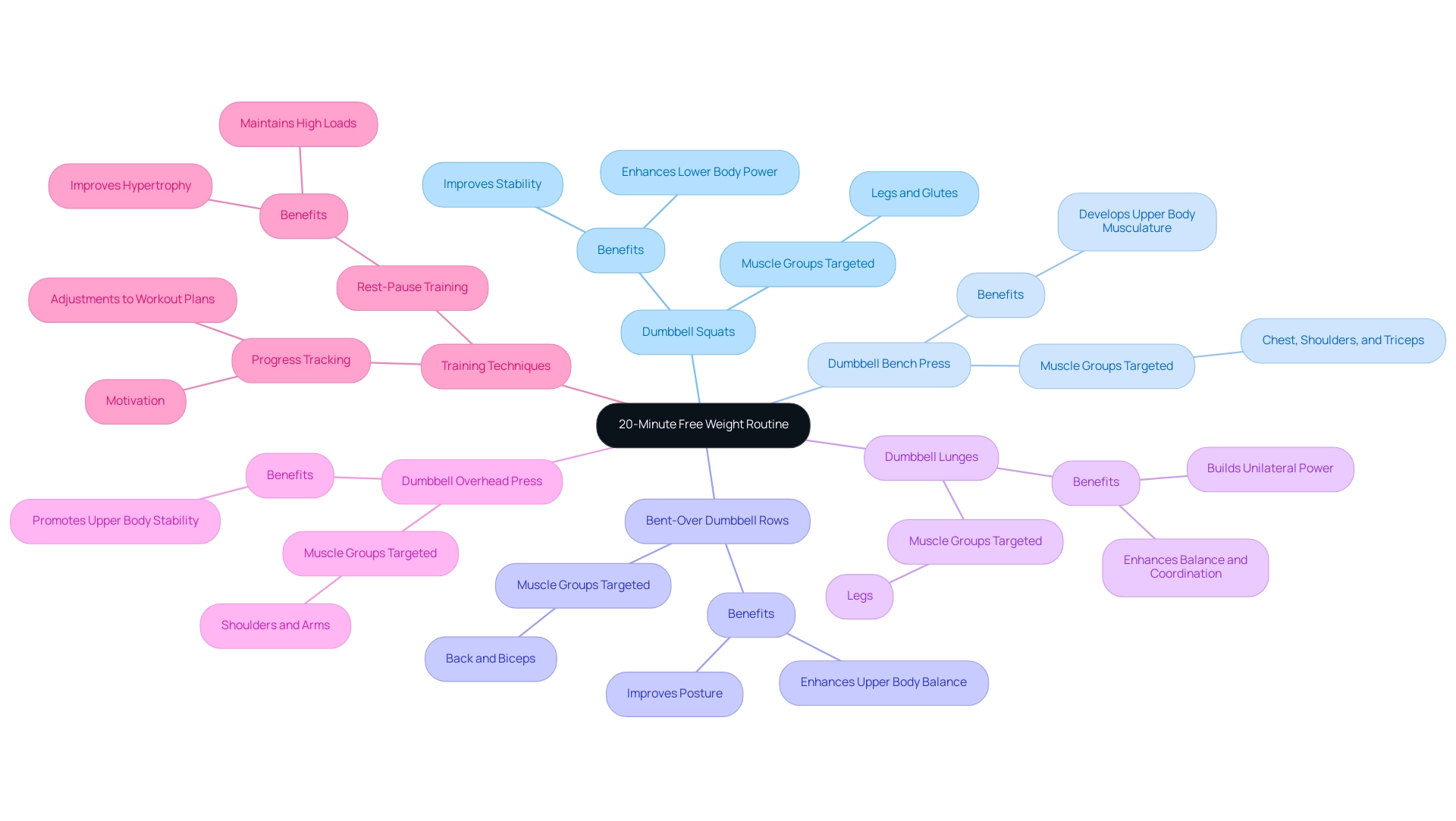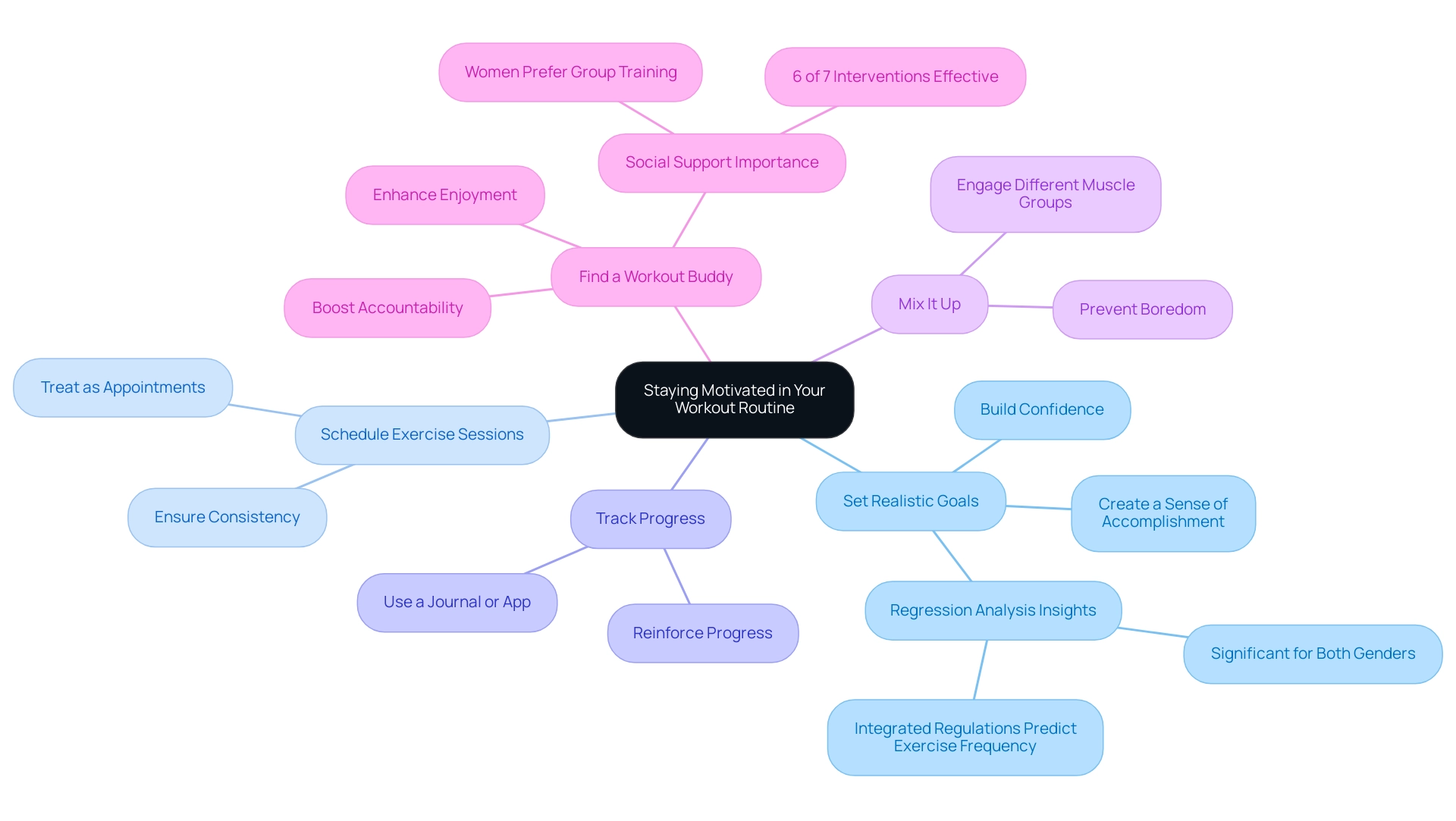Overview
A 20-minute free weight workout is an efficient exercise routine that targets major muscle groups, enhancing strength, endurance, and overall health, making it ideal for individuals with busy schedules. The article supports this by detailing the workout's structure, including warm-up, resistance training, and cool-down, while emphasizing the significant health benefits and motivation strategies that facilitate adherence to such a time-efficient fitness regimen.
Introduction
In a world where time is often a luxury, the 20-minute free weight workout emerges as a beacon of efficiency for fitness enthusiasts and busy individuals alike. This compact exercise session not only targets major muscle groups but also promises significant health benefits, making it an ideal solution for those looking to enhance their strength and endurance without lengthy gym visits.
Supported by innovative health coaching apps, these workouts provide structured programming and personalized guidance, ensuring that participants can maximize their efforts in a short timeframe. With research backing the effectiveness of high-intensity training, this approach not only fits seamlessly into hectic schedules but also fosters motivation through community engagement and goal-setting.
Discover how to optimize your fitness routine with this powerful 20-minute regimen that champions both health and convenience.
Defining the 20-Minute Free Weight Workout
A 20 minute free weight workout is a highly effective activity designed to maximize limited time while utilizing free weights such as dumbbells and kettlebells. This targeted method engages major muscle groups through a range of exercises, enhancing strength, endurance, and overall well-being. Enhanced by our comprehensive health coaching app, you can access daily programming, video demonstrations, movement flows, and nutrition guidance that assist you through these efficient exercises.
The structured nature of these sessions aligns well with moderate-to-vigorous physical activity guidelines, demonstrating that even brief periods of vigorous activity can yield significant health benefits. Notably, research suggests that after approximately 32 weeks of consistent training, individuals may experience optimal adaptations, enhancing their fitness levels. Furthermore, a study indicates that there is no harmful effect of high, long-term vigorous physical activity on cardiovascular health, reinforcing the safety and efficacy of such exercises.
The psychological aspects influencing exercise adherence are crucial; specifically, the analysis highlights that setting short-term performance goals can greatly improve motivation, particularly for those who are overfat. Our app facilitates this by allowing for direct messaging with coaches for personalized support and fostering community engagement through features like group challenges and forums, which enhance motivation. Consequently, a 20 minute free weight workout serves as an excellent option for busy individuals seeking effective fitness solutions without the need to spend hours at the gym, especially when complemented by tailored programs and resources from Foresight Health Coaching.

The Benefits of Short Workouts: Health, Efficiency, and Convenience
Participating in brief exercise sessions, particularly a 20 minute free weight workout, offers numerous health advantages, including improved cardiovascular health, greater muscle strength, and enhanced flexibility. These effective routines are crafted to effortlessly integrate into hectic schedules, enabling individuals to exercise wherever they are—at home, in the gym, or outdoors. Notably, recent studies indicate that high-intensity exercises, even when condensed into a mere 20 minutes, can produce fitness gains comparable to those achieved through longer sessions.
For instance, a study conducted by Flockhart et al. (2021) demonstrated significant improvements in glucose tolerance and lipid oxidation among young, healthy individuals participating in a progressive high-intensity interval training program over four weeks. Furthermore, studies indicate a projected alteration in physical activity of 2770 steps daily, with a standard deviation of 1700 steps per day, emphasizing the possible influence of these brief exercises on daily activity levels.
As noted by Whyte et al., 'the obtained findings demonstrated SIT to be effective in increasing PPO in overweight and obese men,' further supporting the efficacy of short, high-intensity exercises. However, it's essential to acknowledge that further research is needed to determine the safety and efficacy of high-intensity interval training protocols in clinical populations. Such findings highlight the practicality and effectiveness of a 20 minute free weight workout, appealing to anyone facing time constraints.
As noted by health experts, these short bursts of physical activity not only maximize efficiency but also significantly contribute to overall health and well-being, aligning with the ongoing exploration of their impact on fitness in 2024.

Structuring Your 20-Minute Free Weight Workout for Maximum Impact
To effectively organize a 20-minute free weight workout, it is essential to start with a warm-up lasting about 5 minutes to adequately prepare the body for the upcoming activities. As mentioned in a 2019 review, resistance training with elastic bands can offer comparable gains in power as traditional equipment, making it a valuable option for beginners. After the warm-up, participate in a series of resistance training activities, completing 2-3 sets of 8-12 repetitions for each movement.
To maintain intensity, keep rest periods between sets minimal, as supported by research indicating that varying rest intervals can optimize gains in power and hypertrophy. Incorporating compound movements, such as:
- Squats
- Deadlifts
- Bench presses
is crucial as these exercises activate multiple muscle groups simultaneously, providing a more efficient training session. As one expert wisely stated, "One of the worst things you can do when time is short is head to the gym without a plan."
After completing the strength segment, conclude with a cool-down period, which is vital for recovery and flexibility. This structured approach not only enhances performance but also aligns with evidence suggesting that a well-planned 20 minute free weight workout can yield significant results.

Key Exercises for Your 20-Minute Free Weight Routine
A well-rounded 20 minute free weight workout should concentrate on key movements that efficiently engage multiple muscle groups. Here are essential movements to include:
-
Dumbbell Squats: This fundamental movement primarily focuses on the legs and glutes, enhancing lower body power and stability.
Incorporating squats into your routine can lead to significant improvements in functional fitness.
-
Dumbbell Bench Press: A staple for upper body power, the bench press effectively engages the chest, shoulders, and triceps, making it a critical component for developing overall upper body musculature.
Bent-Over Dumbbell Rows: This movement is excellent for strengthening the back and biceps, contributing to better posture and upper body balance.
It’s an efficient way to develop power in the posterior chain.
-
Dumbbell Lunges: Lunges not only work the legs but also enhance balance and coordination. This activity aids in building unilateral power, which is essential for athletic performance and everyday tasks.
-
Dumbbell Overhead Press: Targeting the shoulders and arms, this movement is vital for upper body power and stability, promoting functional movement patterns that are essential for various physical tasks.
Integrating these exercises into your routine ensures a balanced workout that effectively addresses major muscle groups. The benefits of compound movements, such as dumbbell squats and bench presses, allow for maximum efficiency, particularly in a 20 minute free weight workout. Furthermore, employing rest-pause training techniques can improve hypertrophy and power gains, as shown in research contrasting its efficacy with conventional resistance training.
A 2017 systematic review found that short rest intervals (<1 min) produced robust strength gains, making it a valuable strategy for those with limited time. As Christine Ogbonna, a physical therapist, emphasizes, shorter exercise sessions provide an accessible way for individuals with busy schedules to integrate activity into their day without feeling overwhelmed. Monitoring progress with these exercises can also maintain motivation and enable necessary adjustments to achieve fitness objectives.

Staying Motivated: Tips for Consistency in Your Workout Routine
Maintaining motivation in your exercise routine can often present challenges, but several effective strategies can help you stay consistent and committed. Here are some key tips to foster exercise adherence:
- Set Realistic Goals: Establish achievable objectives to build confidence and create a sense of accomplishment. This aligns with findings from a regression analysis indicating that integrated regulations are significant predictors of exercise frequency and duration for both genders.
- Schedule Exercise Sessions: Treat your exercise sessions like essential appointments in your calendar, ensuring they receive the attention they deserve.
- Track Progress: Utilize a journal or mobile app to monitor your improvements, which reinforces your progress and keeps you motivated.
- Mix It Up: Introduce variety into your exercises to keep things interesting and challenging. This not only prevents boredom but also engages different muscle groups, enhancing overall fitness.
- Find a Workout Buddy: Exercising with a friend can significantly boost accountability and enjoyment. Women driven by connection are more inclined to engage in group training than seek exercise independently, rendering this approach especially impactful.
Indeed, a study revealed that 6 of 7 interventions supporting the SDT-based intervention group showcased the efficacy of social support in sustaining exercise regimens. By implementing these strategies, you can cultivate a sustainable and enjoyable workout routine that supports your fitness goals. As Hannah Peters, a Health Fitness Instructor, wisely states,
If you’re not sure how to get started, the trainers at NIFS can help you set goals and develop programs tailored to those goals.
Remember, consistency is crucial; even if plans don't always unfold as expected, staying committed to your routine is key to achieving long-term success.

Conclusion
The 20-minute free weight workout offers a practical solution for individuals seeking to improve their fitness without the time commitment of longer sessions. By effectively targeting major muscle groups through compound exercises, this workout not only builds strength and endurance but also aligns with health guidelines promoting vigorous physical activity. The integration of health coaching apps further enhances the experience, providing structured programming and community support that can significantly boost motivation and adherence.
Short workouts have been shown to deliver impressive health benefits, including improved cardiovascular health and increased muscle strength, making them an excellent choice for busy lifestyles. Research underscores that high-intensity training, even in condensed formats, can yield results comparable to traditional, longer workouts. This efficiency, combined with the ability to perform these exercises anywhere, makes the 20-minute routine accessible to all.
To maximize the impact of a 20-minute workout, a well-structured approach is essential. Incorporating key exercises such as:
- Dumbbell squats
- Bench presses
- Lunges
ensures a balanced and effective routine. Additionally, maintaining motivation through realistic goal-setting, scheduling, and social support can foster long-term commitment to fitness.
Ultimately, the 20-minute free weight workout stands as a testament to the idea that effective exercise doesn't require a significant time investment. By prioritizing health and efficiency, individuals can achieve their fitness goals while seamlessly integrating workouts into their busy lives. Embracing this approach not only enhances physical well-being but also cultivates a sustainable exercise habit that can lead to lasting results.
Frequently Asked Questions
What is a 20 minute free weight workout?
A 20 minute free weight workout is a highly effective exercise routine that utilizes free weights, such as dumbbells and kettlebells, to engage major muscle groups, enhancing strength, endurance, and overall well-being.
How does the workout align with physical activity guidelines?
The structured nature of the 20 minute workout aligns with moderate-to-vigorous physical activity guidelines, showing that even brief periods of vigorous activity can provide significant health benefits.
What are the benefits of participating in a 20 minute free weight workout?
Benefits include improved cardiovascular health, greater muscle strength, enhanced flexibility, and the ability to integrate exercise into busy schedules, allowing workouts at home, in the gym, or outdoors.
How can the health coaching app enhance the workout experience?
The app offers daily programming, video demonstrations, movement flows, and nutrition guidance, assisting users in performing efficient exercises and providing personalized support through direct messaging with coaches.
What psychological factors influence exercise adherence?
Setting short-term performance goals can significantly improve motivation, especially for individuals who are overweight or obese, and the app fosters community engagement through group challenges and forums.
What does research say about the effectiveness of short, high-intensity workouts?
Studies indicate that high-intensity exercises, even condensed into 20 minutes, can produce fitness gains comparable to longer sessions, with improvements in glucose tolerance and lipid oxidation noted in recent research.
Are there any safety concerns regarding high-intensity interval training?
While current findings support the efficacy of short, high-intensity exercises, further research is needed to determine the safety and efficacy of high-intensity interval training protocols in clinical populations.
Who can benefit from a 20 minute free weight workout?
This workout is particularly appealing to busy individuals seeking effective fitness solutions without needing to spend hours at the gym, making it suitable for anyone facing time constraints.

